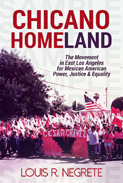
 |
Chicano Homeland: The Movement in East Los Angeles for Mexican American Power, Justice, and Equality
by Louis R. Negrete
CreateSpace Independent Publishing Platform
With current cries about building a wall, this timely book details the history of the Chicano movement that began in the 1950s and continued through the mid-1970s. Early Chicano activists were among the first anti-war protestors since Vietnam death records for Chicano soldiers were considerably higher than their "Gringo" (white) officers. Calling themselves the Bronze nation, the activists aligned with national racism groups against prejudice toward all colors. During these twenty years, Chicanos added many groups to their “enemy list.” Due to various provocations, the list has included churches, the law, politics, and government officials―both Democrats and Republicans. When activists used non-passive methods, the police were added to the list and, eventually, immigration authorities for attempts to deport undocumented migrant workers.
In this exposé/memoir, the author does his best to sum up why Mexican Americans (as this group prefers to be called) remain disgruntled. They resent poorly-funded schools, high dropout rates, and rising poverty levels. Protests have resulted in bilingual studies and Chicano college courses. Other issues that still require work include low voter turnout (even with Chicano candidates) and no resolution for undocumented workers.
Negrete was “eyes and ears on the ground” in the LA area during those years as a student, teacher, and then Head Start director. The author met many well-known leaders of the era, from UFW leaders César Chávez and Dolores Huerta to the Brown Berets. Despite having no glossary or index, the author defines within the text Hispanic terms, such as barrio (poor neighborhood). His detailed table of contents is a helpful navigation tool. At the end of this thoroughly documented 136-page book, the author passionately hands off the baton of Chicano activism to this generation. Having experienced the less than successful history of talking and committees, he ends with a call for positive action.